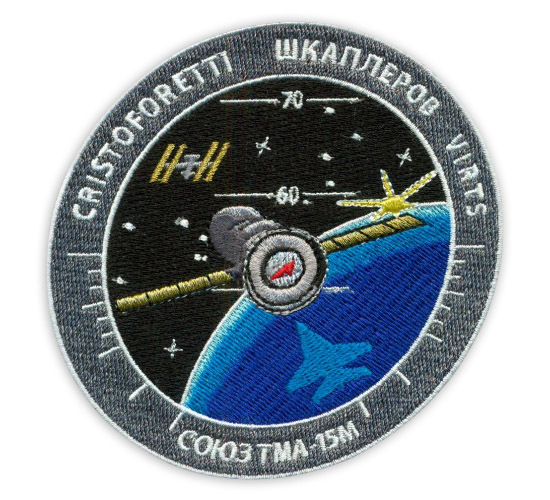Soyuz TMA-15M
ISS-42/43
Callsign: Astraeus
The Soyuz TMA-15M crew members


Crew
Anton Shkaplerov (Russia), Soyuz TMA-15M commander, ISS-42/43 flight engineer
Samantha Cristoforetti (Italy), Soyuz TMA-15M and ISS-42/43 flight engineer
Terry W. Virts (USA), Soyuz TMA-15M and ISS-42 flight engineer, ISS-43 commander
Backup crew
Oleg Kononenko (Russia), commander
Kimiya Yui (Japan), flight engineer
Kjell N. Lindgren (USA), flight engineer
PATCH
MISSION PROFILE
The patch is based on the shape and features of the artificial horizon, the main element of the aircraft dashboard (all three crew members are pilots).
The depicted position of the spacecraft corresponds to a roll angle of 15° (the Soyuz TMA serial number of this spacecraft) and a pitch angle of 51° (orbital inclination). The shadow in the form of an aircraft, combining elements of the MiG-29, F-16 and AMX, accompanies the flight of the spacecraft and indicates the inextricable link between aviation and astronautics.
The depicted position of the spacecraft corresponds to a roll angle of 15° (the Soyuz TMA serial number of this spacecraft) and a pitch angle of 51° (orbital inclination). The shadow in the form of an aircraft, combining elements of the MiG-29, F-16 and AMX, accompanies the flight of the spacecraft and indicates the inextricable link between aviation and astronautics.
Mission duration
hours
minutes
16
42
days
199



23 November 2014
21:01:14 UTC
21:01:14 UTC
Launch
24 November 2014
02:48:21 UTC
02:48:21 UTC
Docking
Rassvet Research module MRM-1
Docking port
Soyuz-FG
Launch vehicle
Baikonur Site 31
Launch site
11 June 2015
10:20 UTC
10:20 UTC
Undocking
11 June 2015
13:44:02 UTC
13:44:02 UTC
Landing
Kazakhstan, 161 km southeast of Zhezkagan
Landing site
PREPARATION AND LAUNCH
On October 30, 2014, comprehensive examination training for the prime and backup crews of the Soyuz TMA-15M manned spacecraft began in the Gagarin Cosmonaut Training Center. According to the planned repair work of the infrastructure of launch complex No. 1, a decision was made to launch from the launch complex of site No. 31.
In accordance with the pre-launch schedule, on November 23, specialists from the enterprises of the rocket and space industry began operations to refuel the integrated launch vehicle (ILV) tanks with oxidizer and fuel.
In accordance with the pre-launch schedule, on November 23, specialists from the enterprises of the rocket and space industry began operations to refuel the integrated launch vehicle (ILV) tanks with oxidizer and fuel.
The flight of the Soyuz TMA-15M became the 300th manned flight in the history of cosmonautics
DOCKING
The Soyuz TMA-15M manned spacecraft successfully docked to the ISS in automatic mode on November 24 at 02:48:21 UTC.
After a successful docking, the spacecraft crew boarded the ISS, where they were warmly welcomed by their colleagues: Roscosmos cosmonauts Alexander Samokutyaev and Elena Serova, as well as NASA astronaut Barry E. Wilmore.
After a successful docking, the spacecraft crew boarded the ISS, where they were warmly welcomed by their colleagues: Roscosmos cosmonauts Alexander Samokutyaev and Elena Serova, as well as NASA astronaut Barry E. Wilmore.
MISSION PROGRAM
During the ISS-43/44 expeditions, 688 sessions were implemented in 72 experiments.
54 experiments started in previous expeditions, 12 experiments were new. The new OASIS experiment was performed according to NASA protocol; five of the experiments were NASA medical experiments and were performed as part of a one-year flight involving a Russian cosmonaut.
54 experiments started in previous expeditions, 12 experiments were new. The new OASIS experiment was performed according to NASA protocol; five of the experiments were NASA medical experiments and were performed as part of a one-year flight involving a Russian cosmonaut.
Experiments
2 cargo ships were received as a part of the mission
Dragon SpX-6
Progress M-26M
(6th SpaceX ISS supply ship)
(58th Russian ISS supply ship)
Progress M-27M
(59th Russian ISS supply ship)
One cargo ship was lost
During an abnormal separation from the launch vehicle, the ship was damaged, put into an off-design orbit, with uncontrolled rotation around its axis. The ship’s control was lost. After a number of unsuccessful attempts to regain control, it was decided not to try to dock the spacecraft to the ISS manually. The ship continued its gradual lowering of the orbit and on May 8, 2015 burned out in the dense layers of the atmosphere.
Algometry, Interaction-2, DAN, Content, Correction, Neuroimmunity, Liquids Movement, Pilot-T, UDOD, Constant-2, Producent, Fagen
Cognition, Fine Motor Skills, Reaction Self-Test, Ocular Health and Sleep Monitoring
INCIDENTS
On June 9, 2015, at 15:32 UTC, during the scheduled testing of the rendezvous and docking radio system of the International Space Station and the Soyuz TMA-15M manned transport spacecraft, the spacecraft’s engines started abnormally (and worked for about 30 seconds), which led to a slight change in the position of the ISS. Necessary measures were taken to stabilize the ISS. There was no threat to the crew, the station, or the ship.
After a series of failures during the launches of Russian launch vehicles, it was decided to postpone the landing of the Soyuz TMA-15M spacecraft for a month. Because of this, the duration of stay in orbit of the Soyuz TMA-15M crew increased from the planned 169 to 199 days.
After a series of failures during the launches of Russian launch vehicles, it was decided to postpone the landing of the Soyuz TMA-15M spacecraft for a month. Because of this, the duration of stay in orbit of the Soyuz TMA-15M crew increased from the planned 169 to 199 days.
DEORBIT
07:04 UTC
Closing hatches between the ISS and Soyuz TMA-15M
10:20 UTC
Undocking from station
12:51 UTC
Turning on the brake engine
13:13 UTC
Separation of ship modules
At 13:44:02 UTC, the Soyuz TMA-15M descent vehicle landed safely in a given area of Kazakhstan, 161 kilometers southeast of the city of Zhezkazgan.
The flight extension allowed Samantha Cristoforetti to break the record for continuous stay in orbit for a female astronaut, previously set by NASA astronaut Sunita Lyn Williams (195 days).
HERO OF RUSSIA
COSMONAUT #111
COSMONAUT #111
Made by
© 2022-2023 Cosmonaut, Hero of the RF
Shkaplerov Anton
Shkaplerov Anton






